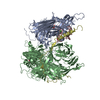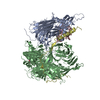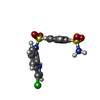+Search query
-Structure paper
| Title | Structural basis of indisulam-mediated RBM39 recruitment to DCAF15 E3 ligase complex. |
|---|---|
| Journal, issue, pages | Nat Chem Biol, Vol. 16, Issue 1, Page 15-23, Year 2020 |
| Publish date | Dec 9, 2019 |
 Authors Authors | Dirksen E Bussiere / Lili Xie / Honnappa Srinivas / Wei Shu / Ashley Burke / Celine Be / Junping Zhao / Adarsh Godbole / Dan King / Rajeshri G Karki / Viktor Hornak / Fangmin Xu / Jennifer Cobb / Nathalie Carte / Andreas O Frank / Alexandra Frommlet / Patrick Graff / Mark Knapp / Aleem Fazal / Barun Okram / Songchun Jiang / Pierre-Yves Michellys / Rohan Beckwith / Hans Voshol / Christian Wiesmann / Jonathan M Solomon / Joshiawa Paulk /   |
| PubMed Abstract | The anticancer agent indisulam inhibits cell proliferation by causing degradation of RBM39, an essential mRNA splicing factor. Indisulam promotes an interaction between RBM39 and the DCAF15 E3 ligase ...The anticancer agent indisulam inhibits cell proliferation by causing degradation of RBM39, an essential mRNA splicing factor. Indisulam promotes an interaction between RBM39 and the DCAF15 E3 ligase substrate receptor, leading to RBM39 ubiquitination and proteasome-mediated degradation. To delineate the precise mechanism by which indisulam mediates the DCAF15-RBM39 interaction, we solved the DCAF15-DDB1-DDA1-indisulam-RBM39(RRM2) complex structure to a resolution of 2.3 Å. DCAF15 has a distinct topology that embraces the RBM39(RRM2) domain largely via non-polar interactions, and indisulam binds between DCAF15 and RBM39(RRM2), coordinating additional interactions between the two proteins. Studies with RBM39 point mutants and indisulam analogs validated the structural model and defined the RBM39 α-helical degron motif. The degron is found only in RBM23 and RBM39, and only these proteins were detectably downregulated in indisulam-treated HCT116 cells. This work further explains how indisulam induces RBM39 degradation and defines the challenge of harnessing DCAF15 to degrade additional targets. |
 External links External links |  Nat Chem Biol / Nat Chem Biol /  PubMed:31819272 PubMed:31819272 |
| Methods | EM (single particle) / X-ray diffraction |
| Resolution | 2.3 - 3.54 Å |
| Structure data | EMDB-10213, PDB-6sj7:  PDB-6ud7:  PDB-6ue5: |
| Chemicals |  ChemComp-EF6:  ChemComp-GOL:  ChemComp-HOH:  ChemComp-Q5J: |
| Source |
|
 Keywords Keywords |  ONCOPROTEIN / ONCOPROTEIN /  DDB1 / DDB1 /  LIGASE / LIGASE /  E3 ligase / neosubstrate E3 ligase / neosubstrate |
 Movie
Movie Controller
Controller Structure viewers
Structure viewers About Yorodumi Papers
About Yorodumi Papers






